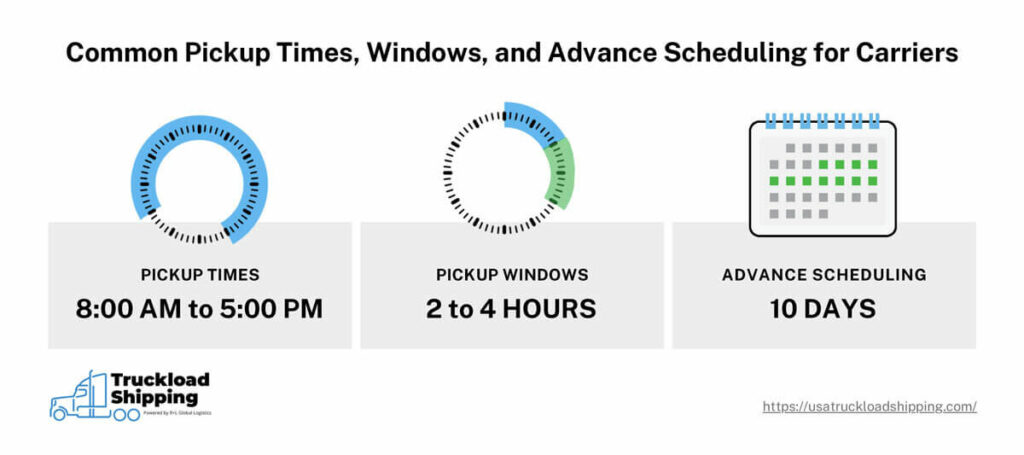A smooth freight pickup is the first step to making sure your shipment gets where it needs to go. When everything runs efficiently, your supply chain stays on track, customers stay happy, and your team avoids unnecessary stress. Having a clear, reliable process in place is essential. Let’s take a closer look at how scheduling a freight pickup works.
Key Takeaways:
We’re going to discuss this information in more depth to help you schedule a freight pickup.
Before you reach out to schedule a pickup, it’s important to gather some key pieces of information. Having everything ready upfront helps prevent delays, quote issues, or rescheduling.
Carriers and 3PLs rely on accurate load information to quote shipments, assign the right equipment, and coordinate efficiently. We’ve provided a list of essential information about your freight you’ll need on hand prior to scheduling a pickup.
Make sure you know the:
If you are unsure how to calculate your freight class properly, ensure you are providing all the needed dimensions that would allow the carrier or 3PL to determine it. They will then go on to assign your LTL freight a National Motor Freight Classification code.
If your shipment requires special handling, such as refrigeration, be sure to include that too. Giving your 3PL the full picture helps avoid misquotes or equipment mismatches.
Related: 3PL vs Freight Broker
Accurate pickup and drop-off addresses are essential. This information tells carriers where to go and allows them to more accurately plan out their routes. You’ll also need to provide additional details about each pickup and dropoff location.
This includes:
If the pickup or delivery location doesn’t have a dock, you’ll likely need to add liftgate services to your shipment when you request pickup. Specifying whether locations are business or residential will help carriers navigate these areas.
The same can be said when you determine if there are any access restrictions they’ll need to navigate at each location. Finally, clarifying hours of operations ensures the carrier doesn’t perform pickup or delivery at the wrong time, which can increase your costs. We’ve provided some common pickup windows and cutoff times within the industry.

In some cases, carriers may agree to come after typical business hours. However, this will vary based on the transportation provider.
You’ll need to compile contact information for you and the receiver of your freight.
This includes:
When compiling these details, be sure to provide full names, phone numbers, and email addresses. If the driver can’t get in touch with anyone on-site, it could delay your pickup. If possible, find backup contact information as well. This is especially helpful if your warehouse or store has rotating staff.
Now that you have all the information you need, you can start scheduling your freight pickup. Depending on how your 3PL or carrier operates, you’ll be able to set a pickup time using different options.
Many 3PLs and carriers allow shippers to schedule a freight pickup using a Transportation Management System (TMS) or customer portal. In either instance, you’ll have to create an account. From there, you’ll need to enter all the shipment, pickup, and contact information you have available.
Review the details you provide to make sure it’s all correct. If you ship regularly, using a portal can save time and give you better visibility into your freight operations. It also keeps all your orders, documents, and tracking links in one place.
Sometimes, especially for one-off or urgent shipments, you might prefer to just call or email your 3PL contact.
This works well when:
Just make sure your message includes all the details we mentioned above—shipment specs, addresses, and contact info. The more complete your request, the faster a carrier your 3PL can schedule your freight.
When the transportation provider reaches out, they might ask for additional information to finalize the shipment. From there, you’ll need to provide your payment details, which you should never just leave in a voicemail or email message.
Once your freight is scheduled, you’ll receive a pickup confirmation through an email or your customer portal. This will include the estimated pickup window and driver information
Take care of these responsibilities beforehand:
Make sure your freight is packed, secured to a pallet, and labeled
Have your Bill of Lading (BoL) printed and signed
Keep your dock or pickup area clear for the driver
When your carrier arrives, they’ll need to check in and confirm your paperwork. Afterward, the loading process will commence. The company should then provide tracking that you can monitor, either through a link or from your account portal.
Even experienced shippers make small mistakes that can lead to big delays. We’ve listed common mistakes that you should avoid before scheduling a pickup.
Avoiding these mistakes will ensure smooth freight pickup for your freight and prevent unnecessary expenses.
Related: 10 Ways to Reduce Freight Costs
At the end of the day, scheduling a freight pickup doesn’t have to be complicated. With the right 3PL partner and a solid process in place, it can be one of the easiest steps in your workflow. At USA Truckload Shipping, we’re here to make that happen with our quick and reliable services.
If you’re ready to schedule your next freight pickup or want to explore how we can support your logistics needs, fill out a Request for Proposal (RFP) today. For questions or immediate support, give us a call at (866) 353-7178 or visit USA Truckload Shipping’s contact page.
R+L Global Logistics
315 NE 14th St., Ocala, FL 34470